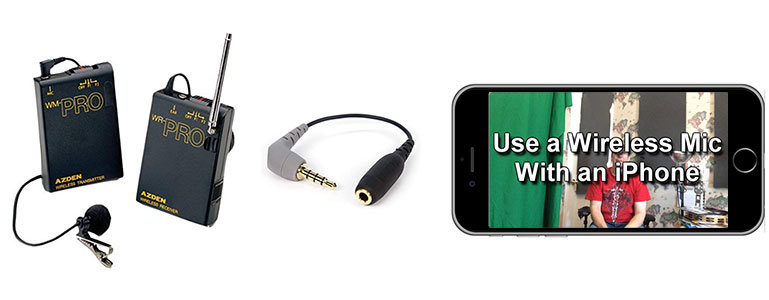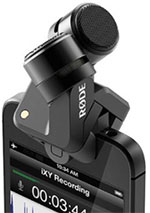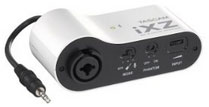 Looking for a wireless microphone for iPhone? Here is how to make any wireless mic work with an iPhone.
Looking for a wireless microphone for iPhone? Here is how to make any wireless mic work with an iPhone.
Recently, a friend asked me how he could use an external microphone on his iPhone to shoot video.
Why Would I Want To Use a Wireless Microphone With An iPhone?
The basic reason for using an external/3rd-party mic is pretty easy, since any number of companies now have good mics available specifically for iPhone/iPad use (like the Zoom iQ6, the Rode iXY, and the Blue Mikey Digital, to name a few).
All those companies, however, assume you will be close to the mic, using it as a mobile field recorder or in the studio to record music.
Why Does The Mic Need To Be Close?
Shooting video when your subject is many feet away from the mic usually yields pretty poor audio. See my article, along with a video, which shows you how to solve this problem, here: How To Get Good Audio On Your Videos.
My friend wanted to do just that: use his iPhone to record video of himself from several feet away. And to make things just a little bit more difficult, he wanted to be able to move around. So he needed a wireless microphone for his iPhone.
How Do You Make That Happen?

Now, if he were using a regular video camera / camcorder, I would refer him to the advice in the above article.
If it has an external mic jack, I would say to use that camcorder with a wireless lapel mic Azden WMS Pro).
If that camcorder does NOT have an external mic jack, I would say to simply record onto either a good handheld digital field recorder (like the Zoom H6) or directly into a computer through a decent audio interface (like a Focusrite Scarlett).
In all those scenarios, you’d want the microphone as close to your mouth as possible.
The Challenge For My Friend’s Video Needs
But he wasn’t using a camcorder, he was using an iPhone. At first, I thought it might be possible to plug the 1/8th-inch pin on my Azden wireless receiver directly into the iPhone’s dual headphone/mic jack – it certainly fits in there. But nope, that doesn’t work as a wireless microphone for iPhone, primarily because Apple built their jack to accept very specific types of plugs which carry just the right kind of signal.
So though it might fit in the hole, an external mic will not work like that with iPhones – it needs a little help.
The Solution For Using a Wireless Microphone for iPhone
That help comes in the form of a humble-looking little cable about 12 inches long. Technically it is a 4-pole male connector (they have 3 strips on the pin) on one end and a female adapter on the other. There are a few out there. The one I tested in the video below is the KVConnection KM iPhone Microphone Adapter. But that doesn’t appear to be available any longer. So here is one by Rode: Rode SC4 3 inches Microphone Cable.
This little puppy (which costs $14.28) converts a normal microphone plug into the type that an iPhone wants in order to recognize the mic – a 4-pole “TRRS” (tip-ring-ring-sleeve).
You simply insert your mic’s plug into the female end of the Rode adapter, and THEN plug the Rode’s 1/8th-inch pin into the iPhone jack, and “hey presto,” “Bob’s your uncle,” etc.
You can stand across the room with the Azden lapel mic stuck to your shirt and walk around to your heart’s content. The lapel mic will beam its wireless audio signal to the Azden receiver, which is plugged into the KM adapter.
Is There A Video Demonstrating This?
Why yes there is:). I didn’t have a special “wireless mic for iphone.” But I did have an Azden WMS wireless lavalier. In the video below, I compare the audio with video shot with my iPhone 5S, first using just the built-in mic, then with the audio that came through the wireless mic attached as described above.
If you have headphones, I recommend using them to get the full effect of how different the two audio samples sound.
[jwplayer mediaid=”18146″]

By the way, there are other products that allow you to plug external microphones into iDevices. One that is a fantastic all-in-one solution is the Samson Go Mic Mobile Smartphone Wireless Microphone.
Another one that looks really useful is the Tascam iXZ Instrument/Mic, which you can plug XLR and 1/4-inch microphones – basically, most standard mic cables – into.
I’m glad my friend asked that question. Now I know how to plug a wireless mic into an iPhone, and so do you!

Hi,
Great stuff, thanks! How/where do you setup your receiver with the iPhone? I have the shoe mount and a tripod (to put my phone in) but I don’t think I can put the shoe mount anywhere. Help, please.
Thanks,
Marie
That’s a really good question! I’ve never really found a good place to put it even when using a camcorder. I usually slide it inside the strap for the hand-hold. But for the iPhone, there isn’t really an obvious place. I was shooting this video in a controlled space in my studio, and used a mini-tripod with an iPhone mount. Since that sat on a desk, I just set the receiver on the desk next to it. But if you were going to be using it out-and-about, I suppose you could use a rubber band or some other kind of strap set-up. I know that isn’t much help:-P. But at least you know this problem is shared by at least one other person:).
Ken
Thanks, Ken! That’s great to know that I wasn’t missing something right in front of me Thanks for a prompt response and thanks for an amazing tutorial on this article, it helped a lot! I purchased the Azden WMS-PRO and the KVConnection iPhone adapter like what you’ve mentioned. I’ll be testing it tomorrow
Thanks for a prompt response and thanks for an amazing tutorial on this article, it helped a lot! I purchased the Azden WMS-PRO and the KVConnection iPhone adapter like what you’ve mentioned. I’ll be testing it tomorrow 
You’re welcome, Marie! Here’s to great sounding audio on videos!
Cheers,
Ken
Definitely, Ken!
Ken, so sorry, got another question for you. I tested my mic just now and I’m not getting any sound. It seems to me that the phone is picking up the right audio but it’s not picking up the audio.
I have the adapter plugged into my phone and the mic’a plug into the receiver; the antenna is also all the way up. My receiver and transmitter are both turned on – I tried it when both are on F1 and also on both F2. I tried with the earphone plugged in on the receiver and without. I couldn’t produce any sound.
Do you have ideas on what I could be missing?
Definitely, Ken!
Ken, so sorry, got another question for you. I tested my mic just now and I’m not getting any sound. It seems to me that the phone is picking up the right audio but it’s not picking up the audio.
I have the adapter plugged into my phone and the mic’s plug into the receiver; the antenna is also all the way up. My receiver and transmitter are both turned on – I tried it when both are on F1 and also on both F2. I tried with the earphone plugged in on the receiver and without. I couldn’t produce any sound.
Do you have ideas on what I could be missing?
Oh nevermind, I got it figured out It looks like I didn’t have a green light on my receiver because I had the battery turned on backward. Thank you!
It looks like I didn’t have a green light on my receiver because I had the battery turned on backward. Thank you!
Glad you got it figured out:).
Ken
Thanks, I have a regular 1/4 inc to 1/8th inch adapter and wondered why my iPhone still refused to recognize the mic. Correct adapter on the way
Awesome! Hope that works for you. It really makes a difference to have the audio recorded that way – up close to the mouth.
Good luck with it!
Ken
Hello, I have the wireless mic with transmitter and receiver along with an adapter. However, when I try to use them, my iPhone recognizes the adapter for the receiver as a headset, therefore my the wireless mic doesn’t work. Please help, thanks!
Hi Chris. Which setup do you have? And which version of the iPhone? Did you get the KVConnection KM iPhone Microphone Adapter?
Ken
Hi Ken. I’m using a Pyle PDWM96 along with my iPhone 6+. I’m ordering the KVConnection KM iPhone Microphone Adapter today, hopefully that’ll fix it. Thank you!
I think that will do the trick.
Good luck!
Ken
I purchased a Boya BY-WM6 wireless mic system. I connected to my iPhone 6s with a Rode SC4 TRS to TRRS adaptor. The phone doesn’t know its attached. I’m quite confused on why it’s not working. I tried turning up volume on receiver and also flicked volume physical switch on phone then turned volume up and nothing. Any help would be greatly appreciated. Thanks
Hi Wes,
I don’t have the same kind of system. So it’s hard to say. But what recording program are you using on the iphone to record the audio?
All well and good – except you held the mic to your mouth – not what anyone wants to do for their video. Needs to be clipped to your shirt, worn as it would in a shoot to be a good test.
I ordered one and it worked great with Pyle wireless microphone and iPhone.
THANKS for the tip. Now my videos will have a much more professional feel.
That’s AWESOME, Tom! So glad that information helped:).
Cheers,
Ken
Thanks, Ken. The rumble picked up in the room when you’re not using a close-mic makes speech harder to understand. It’s so much more clear with the wireless. When trying to make a professional video, it makes all the difference.
Thanks Jonathan. Yes, distance really does make all the difference.
What wireless lapel mic do you recommend? Thanks!
Hi Steve,
I use the Azden WMS Pro. You can get it on Amazon here.
Ugh, used the exact configuration except I bought the Pyle PDWM96. Not working! No sound! Do I need to do something else besides plug it into the iphone and make sure the power switches are on the wireless mic?
Steve – you used the KVConnections cable and plugged your Pyle into that? If so, that is correct, and I don’t know why it didn’t work. There’s no way for me to know which thing was at fault – your Pyle, the KVConnections cable, your iPhone, the app you’re using to record with your iPhone, etc. I’d recommend testing the Pyle on a regular camcorder (if it has an external mic input) or other audio interface/recorder. You might need a 1/8th inch to 1/4 inch adapter for a regular mixer or other interface. But if your Pyle doesn’t work there, you’ve found your culprit. If it DOES work, then the problem is obviously either KV cable or your phone, etc. I would try making a recording with that same app on your phone but WITHOUT any mics or cables. Make sure you can record something with your phone using that app with just the phone’s normal mic. If that works, then it’s probably the KV cable, and you should try to contact them about this. If you CAN’T record on your phone with that app, try a different app. There are tons available on the App store. Also, try borrowing a different phone.
Those are the only ideas I can offer. One of them should at least identify the weak link in the chain. Hope that helps!
Ken,
You are a very smart guy! Very logical. Thanks for walking me through it!
Thanks Steve Hope you were/are able to get it working for you.
Hope you were/are able to get it working for you.
Hello, I’m just starting out trying to help a friend make YouTube videos for her business. I have an iPhone 6. I’m researching wireless mics and think I may get this:
Movo WMIC10 2.4GHz Wireless Lavalier Microphone System for DSLR Cameras, iPhone
From what I’ve read, I believe I may also need an adapter. Would this work?:
iPhone – Android 1/8 inch microphone adapter – 3.5mm 4 conductor TRRS Male to 3.5mm Microphone Input Jack.
Says is works with Battery Powered Lavaliere Microphones. I think that’s what I’m getting? Thank you for your assistance.
HI Lizz,
Looking at the Movo right now and it looks like it comes with all the adapters you need. The picture here – https://www.movophoto.com/products/wmic10-wireless-microphone-system – shows 4-pole (TRRS) cable(s) in the package. And it says it comes with “3.5mm TRS Output Cable for Cameras, 3.5mm TRRS Output Cable for Smartphones and Tablets.”
I hope that helps.
Will this work with the iPhone7, 8 and X w the lighting to mini adapter since the regular port has been eliminated?
It should work with the adapter, yes. Getting a 4-pole cord to test it should be pretty cheap though. I don’t yet have one of those new iPhones or I’d test it for you myself. Great question though. Thanks! I’ll try to borrow one and do some testing and update the post.
Great article. Lots of useful information. And thank you for using the correct terminology throughout the article. Saw an article above this in my search that was titled, “How to get great audio when filming with an iPhone.” What kind of useful information can you get from someone that has film in their phone? I don’t know. – For me it’s like fingernails on a chalkboard, and I just want to find an eraser.
Thanks Ed!
Hi Ken. Maybe you can answer my question. It’s a little hard to find the exact answer using Google. We have a wireless, over the type microphone that our pastor wears. Up in the sound booth is the receiver that takes the sound and puts into the house speaker system. I’m using my iPhone, on a tripod, sitting in the front row to do Facebook or YouTube Live video of the sermons, but like you stated, the sound quality is poor due to the distance the pastor is from my phone. Can I simply get another receiver that will pick up the same frequency that we already use and plug the output into my phone? I have the iPhone 8+, so even with your method, I would need a lightning jack converter, since there is no headphone jack. If this is not possible, can you recommend a good, directional boom mic that would help pick up the sound better?
Hi Bill. That might actually work, though I don’t know for sure, never having tried it. But perhaps a simpler approach could work. Can you record the audio from the sound booth separately? If you can capture that audio onto a laptop or other mobile recording device, you can sync that audio up with the video after the fact. Though this probably wouldn’t work if you’re live-streaming. One other possibility is to get a separate additional lav mic on a different frequency going to the iPhone. Having two lavs side-by-side shouldn’t be too difficult to do.
Ken, I have the Azden WR-Pro Receiver/WM-Pro Transmitter Wireless Microphone and an iPhone 6S using a QVS CC400FMY-R TRRS adapter cable.
When I plug headphones into the QVS adapter headphone jack, I can hear the wireless microphone, so the Azden is working.
But when I record any video on the iPhone, it seems to use the iPhone’s mic, not the wireless.
I’ve tried a number of different plug arrangements to see if I may have had something the wrong way, but nothing seems to work.
What am I doing wrong here – this seems so straight forward.
-Plug the Lav mic into the Transmitter.
-Plug the single black stripe plug into the Out port of the Receiver.
-Plug the 2 black stripe jack into the Mic port on the adapter cable.
-And then plug the 3 black stripe (4 pole) jack into the headphone port on the iPhone.
Everything looks right – but no audio is going into the iPhone video from the Wireless mic. Thoughts?
Hi Scott. My guess would be the QVS. I looked up the model number you sent me and it looks like it’s more designed as a splitter? My advice would be to order the Rode SC4 3.5mm TRS to TRRS Microphone Cable Adaptor reference in the post. My guess is that will work.